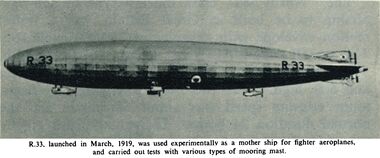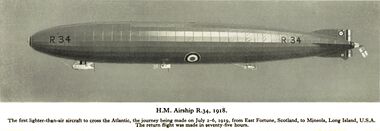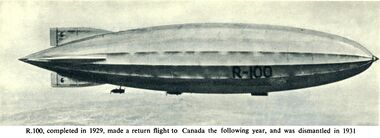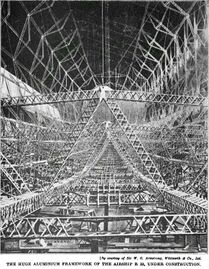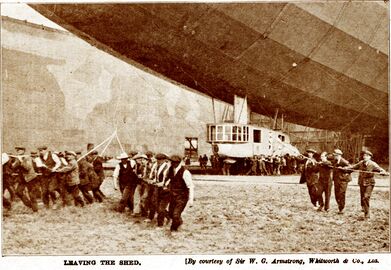Category:British airships
1920: Artist's impression of a future British R-series Atlantic-crossing airship, with the characteristic red, white and blue nose roundel [image info]
R.33 Airship on her trial flight [image info]
R.33 Airship [image info]
R.34 Airship [image info]
R.34 model, Science Museum,London [image info]
R.80 Airship [image info]
R.100 Airship [image info]
R.101 Airship G-FAAW, at the mooring mast at Cardington [image info]
1915-1919: Non-rigid airships
World War One saw the British Navy commission the construction of a range of non-rigid airships (or "blimps") for coastal reconnaissance and convoy escort from early 1915 onwards.
The manufacture of non-rigid airships was a natural development and extension of the WW1 manufacture of non-rigid anti-aircraft balloons to defend cities and military installations, and of "spotter" balloons for use near the front lines, and used the same technology and manufacturing techniques, and drew on the same support infrastructure.
These were especially useful for anti-submarine work, as a submarine that would be invisible from ship height might be easily seen from an airship at altitude, looking almost directly down. In terms of "airship vs. submarine" warfare, the airship also had the unfair advantage that is could drop bombs onto the submarine, while the submarine might not be able to do anything about the airship. Non-rigid airships also had the advantage that they could be easily moved around the country in non-inflated form using lorries, and didn't need hangars for storage when they weren't in use.
Classes
- "Sea Scout" Class
- "P" Class
- "Zero" Class
- "Coastal" Class (late 1915) – crew of five, 50mph cruising speed.
- "Star" Class
- "North Sea" Class – 262 feet long, 55mph cruising speed.
- Non-rigid Airships, 1915-1919
Default operational time was normally 24 hours, but could be longer if required – the N.S.11 "North Sea Class" airship set up an endurance record of 101 hours in 1919
Semi-rigid airships
Although Nulli Secundus (1907) was a semi-rigid type, British airship construction tended not to use this format much, and it had almost disappeared by WW1. The British Government did purchase a German "Parseval" for research, and also an Italian "Forlani", but the delivery of the Italian airship was prevented by the outbreak of WW1.
After this, British design tended to be either non-rigid (cheap mass-produceable balloons for military purposes) or fully-rigid (inspired by the German Zeppelin company).
Rigid airships
H.M.A.1
The Vickers-built HMA No. 1 (retrospectively R-1, and nicknamed Mayfly by its lower-deck crew) appeared in 1911, and was the first of a series of British "R-" airships. Living up (or down?) to its insect nickname, Her Majesty's Airship No.1 had a vanishingly short lifespan, its excessively long, thin body breaking in two as it was being manoeuvred into position to try to attempt its very first test flight.
What Mayfly illustrated was that if one had an airship with a cylindrical middle, an increased number of stacked identical central cylindrical sections increased the stress and strain on those sections without increasing the area over which those stresses and strains could be dissipated. Airships were more robust if they had "bulgy middles".
World War One
Although development initially stalled in 1912, rigid airship development restarted in 1915 due to the War, encouraged by Germany's initially-successful use of Zeppelins, and given a boost by the capture in Essex of downed Zeppelin LZ-76 (L-33), which was then swarmed over by British airship experts, eager to learn everything they could about the current German state-of-the-art design.
Ths wartime boost in investment and R&D between 1915 and 1919 culminated in the R.33, R.34 and R.38.
R.33
R.33 was used as a testbed to explore the idea of using airships as flying aircraft carriers, using small de Havilland DH.53 Humming Bird monoplanes, or 'Gloster Grebe biplanes, slung beneath the body of the airship. The aircraft would be "dropped" by the airship after their motors were running, and on return would be "snagged" by a trapeze, and the hauled back up into position under the ship, after which the pilot could disembark. Bizarrely, this actually seemed to work, although one tends to wince at the idea of the effect of the recapture stresses on the airframe.
R.33 was also used to trial pylon mooring techniques, and although its nose was wrenched off while moored during a gale, the airship survived and returned home 33 hours later, suggesting that R.33 had gotten the basics right, and represented a solid and respectable piece of airship design.
- Building the R.33 airship
R.34
The R.33's "R.33-Class" sister-ship R.34 was a similarly solid piece of airship construction, and in 1919 became the first aircraft of any type to ever cross the Atlantic from East to West, travelling from East Fortune (Scotland) to Long Island, New York, in 108¼ hours. When it made the return journey (in a fraction over 75 hours, due to tailwinds), it also became the first aircraft to ever make a round trip across the Atlantic.
The resilience of the R.34 is demonstrated by the fact that, where it normally only took one mistake or bad weather incident to destroy an airship, with the R.34, it took a chain of three, on 27th January 1921: First, the ship was recalled due to impending bad weather and never received the message ... then the ship ran into a hillside due to a navigation error, but was still flyable and headed out to sea and followed the coastline home during daylight hours ... by which time the weather had worsened, the ship couldn't be manoeuvred into its shed and had to be left tethered and unattended outside, which led to its front end being trashed overnight by the winds. All of this was, in theory, completely avoidable.
R.38
The larger R.38 was rather less successful design, and wasn't finished until 1921. By this time the Great War was over, there was no longer a need for North Sea patrols, and the orders for the rest of the class, R.39, R.40 and R.41, were cancelled. The Royal Navy decided to cut their losses by completing R.38 and selling it to the USA. However, after some troubling test flights, R.38 broke up in flight in August 1921 over the UK, having not yet been sent to America, killing 44 people. With the R.34 also being lost the same year, and no compelling military reason for having more airships, the Air Ministry decided to draw a line under further airship production.
R.80
Indications are that the Barnes-Wallis-designed R.80 might well have turned out to be a decent airship, but, appearing in 1920, it was a military craft with no purpose, as the War was now over. Completed as a civilian ship, it was really a bit too small for civilian purposes, and its structure was also compromised by an accident when it was first taken out of its shed in 1920. The ship was repaired and ready again in 1921, but was only really used to train US servicemen in preparation for the expected hand-over of the R38. After this it was used for destruction-testing.
Imperial Airship Scheme
Although the previous "Burnley" plan for airship strategy had been considered too expensive, the new 1923 Labour government included Lord Thompson as Air Minister. Thompson has been Chairman of the Royal Aeronautical Society and the Royal Aero Club, and was more enthusiastic about airships. Thompson created the Imperial Airship Scheme, in which luxury air travel would link the far corners of the British Empire.
Thompson's scheme was designed to placate potential opposition from all sides rather than have a single monolithic plan, which might have lumbered the government with a bad design, Thompson had two independent competing teams producing two similar (but different) aircraft: further, one team would be a "private industry" team (Vickers) and the other would be a "government" team. Between the two teams, the two sizes, and the two systems of management, all the bases would be covered.
R.100 (1929)
The R.100 team at Vickers was headed by Barnes Wallis assisted by Nevil Shute Norway, and was to be the smaller, more conservatively designed aircraft. Early indications were that the R.100 was a "good" airship, and after early flights in 1929, it successfully carried out a return trip across the Atlantic.
R.101 (1929)
The R.101 was the more ambitious project, pushed forward by Thompson, to produce the World's largest airship. As the government's "prestige" project, the R.101 was pushed forward more quickly and took more chances than were sensible, and consequently crashed on its first proper flight in October 1929, thrown into the ground over France by a downdraught that it was unable to counter. Filled with invited R.101 airship engineers and managers, and Lord Thomson himself, the crash of the R.101 with the deaths of all the passengers, wiped out a stratum of the British airship design community and made the following Minister for Air somewhat less enthusiastic about continuing a scheme that has already killed his predecessor.
After a brief pause for reflection, the R100 project was also scrapped, along with the main airship infrastructure, such as the mooring masts. This effectively meant the end of the passenger airship industry in Britain.
Other airships not listed
As the numbering suggests, there were also a significant number of other British airships, at least on the drawing-boards. Some of these were never built, others were started and abandoned – when the first airship of a class turns out to have problems during testing, it may be that the class is abandoned even though another one or two have been started. Of the other airships that were completed, some may have survived for perhaps two years, but many had a lifespan that was significantly shorter, and didn't significantly catch the public's imagination.
Modelling dimensions
Attempting to model the range of British rigid airships in 1:72 scale gives a range of lengths from over two metres long, to over three metres long!
A more convenient standard scale is the "waterline ships scale", of 1:1200 (one inch to 100 feet) or 1:1250 (0.0008:1).
| Name | Year | People | Length | Width | Length (metres) | Length 1:72 | Length 1:1200 | Length 1:1250 |
|---|---|---|---|---|---|---|---|---|
| H.M.A.1 | 1911 | 20 | 512' 0" | 46' 0" | 156.06m | 2,167mm | 130mm | 125mm |
| R.33, R.34 | 1919 | 26 | 643' 0" | 79' 0" | 195.99m | 2,722mm | 163mm | 157mm |
| R.38 | Year | 28-30 | 695' 0" | 85' 4" | 211.83m | 2,942mm | 176.5mm | 169.5mm |
| R.100 | 1929 | 37 | 719' 9½" | 133' 4" | 219.39m | 3,047mm | 183mm | 175.5mm |
| R.101 | 1929 | 42 | 777' 0" | 131' 4" | 236.83 | 3,289mm | 197mm | 189mm |
Media in category ‘British airships’
The following 18 files are in this category, out of 18 total.
- British Army Airship No3 Baby 1909, Card 13, Aviation (Wills 1910).jpg 3,188 × 1,676; 1.12 MB
- Coastal Class nonrigid Airship C10A (BA2 1944).jpg 3,000 × 2,147; 788 KB
- Coastal Star Class nonrigid Airship CStar10 (BA2 1944).jpg 3,000 × 2,050; 800 KB
- North Sea Class nonrigid Airship NS9 (BA2 1944).jpg 3,000 × 2,123; 816 KB
- R-34 Airship, 1918, model (IHoF 1937).jpg 3,000 × 1,031; 724 KB
- R100 airship (BA2 1944).jpg 3,000 × 1,090; 636 KB
- R101 airship G-FAAW, 1930 (BA2 1944).jpg 3,000 × 1,217; 708 KB
- R33 airship (BA2 1944).jpg 3,000 × 1,249; 423 KB
- R33 airship frame under contruction (WBoA 4ed 1920).jpg 2,327 × 3,000; 1.57 MB
- R33 airship leaving the shed (WBoA 4ed 1920).jpg 3,000 × 2,073; 1.56 MB
- R33 airship on her trial flight (WBoA 4ed 1920).jpg 3,000 × 2,225; 759 KB
- R33 airship under construction (WBoA 4ed 1920).jpg 3,000 × 2,158; 1.31 MB
- R33 airship, cover being fitted (WBoA 4ed 1920).jpg 3,000 × 2,184; 1.31 MB
- R33 airship, the loops or rings of the hull (WBoA 4ed 1920).jpg 3,000 × 1,691; 1,018 KB
- R34 airship (BA2 1944).jpg 3,000 × 2,081; 988 KB
- R80 airship (BA2 1944).jpg 3,000 × 1,521; 741 KB
- Sea Scout Zero Class nonrigid airship SSZ-37 (BA2 1944).jpg 3,000 × 2,169; 863 KB
- The Airship, cover of the Wonder Book of Aircraft (WBoA 4ed 1920).jpg 2,229 × 3,000; 1.87 MB


